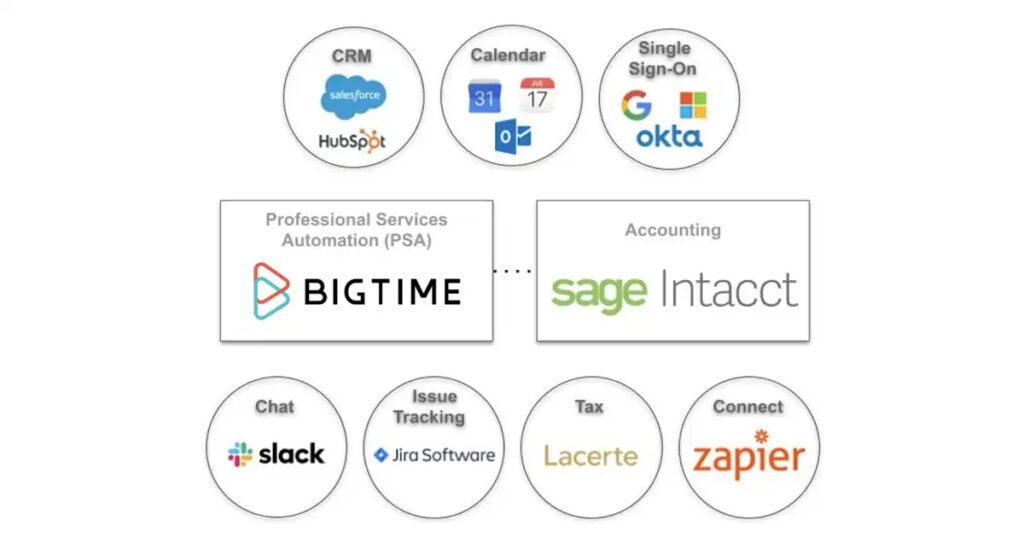Once upon a time, integrations were expensive, never worked, and required a third party to manage them. Fast forward to 2022, where tech stacks reign supreme and legacy/all-in-one solutions are becoming a thing of the past. And while it can sometimes feel overwhelming to navigate through the different products and software out there, finding the right tech stack for your professional services firm doesn’t have to feel impossible.
Keep reading to learn when it’s time to make the switch from an all-in-one approach and how it can help boost your company’s productivity, performance, revenue, and more.
The evolution of integrations and niche software
Over 15 years ago, integrations were a huge pain for all involved. A cumbersome process, software used to be customized and things would often break. We knew back then how important and how valuable getting those connections were, we just weren’t in a place to build and execute them properly.
It’s great to see how far we’ve come and it’s also cool to think that we’ve known for a long time the true power that integrating data and systems could bring to the table. But now, we finally have advanced integration technology and solutions like Professional Services Automation (PSA), Business Intelligence (BI), Client Relationship Management (CRM), and Human Capital Management (HCM). We also now have the ability to find the best pieces of each solution that are needed and leverage them together to get the best results.
It’s thanks to this new technology that we’ve seen a huge rise in niche software. Because there are so many new options out there for specific needs and specific types of businesses, companies are no longer looking to get their solution from one thing in a box, there’s a whole ecosystem of stuff and it just makes sense.
Tell-tale signs your current system is “broken”
Are you experiencing any of these common challenges?
- Data is disconnected and managed manually
- Managers rely on back-office for reporting
- Billing cycles and close times are extended
- Existing processes are not scalable
- Business is run based on software capabilities
These time-consuming challenges can really be tough. People feel disconnected and data can be siloed, resulting in a ripple effect. For example, when billing cycles take forever due to the delay of internal review and client approval, it can be anywhere between 60 to 90 days between work being done and getting paid for it.
Searching for a perfect “all-in-one” solution can create even more pain points:
- Legacy, suite-style systems tend to be strong in one category and below average in others
- Disruption with an all-in-one system is felt company-wide
- These suites are very expensive and difficult to replace
- Tough to scale as the company grows and needs change
These pain points and challenges reveal why there has been a surge in niche software over the past few years. It’s easy to be lured into an all-in-one solution but when you step back and think about these issues, turning to a tech stack approach should be a no-brainer.
Building a scalable tech stack that fuels your growth
When you end up running your business based on what your software is capable of doing, not what you need your software to do, it’s time for a change. For professional services, at the core, you need a solid financial management system and a solid PSA system. Building your tech stack can be pretty great in this day and age. It doesn’t matter if you have Gmail or if you have Microsoft, you can still do the same things. As a business, you can ask yourself, what do I need today and what do I need for the future?
A tech stack doesn’t force you into the mindset of “I bought all this stuff and I’m never going to use it” or even, “I have all these pieces and I don’t like them.” The beauty of a tech stack is that if you’re using a PSA solution like BigTime and you don’t have the need for a CRM today, that’s okay. Need one in a year from now? You can integrate that and it’s seamless.
Things change and businesses grow. The operative word when building your tech stack is momentum. You need to build it as you have momentum and are growing— pick the right thing at the right time.
Below is a great example of a common tech stack for a professional services firm.

BigTime & Sage Intacct: The foundation of your tech stack
The BigTime + Sage Intacct integration seamlessly synchronizes your projects, employees, financials, and accounting data to provide your team the best possible toolset for their specific needs.
There are several ways BigTime & Sage Intacct work together to take your firms’ accounting to the next level:
- No more double entry on all things time, expenses, and invoicing
- Determine settings for posting and importing data with default accounts, default items and locations for posting to Sage Intacct
- Timesheets can be entered and submitted by the staffer and posted directly into Sage Intacct
- Ensure consistency and skip a step by linking BigTime labor codes or categories to a Sage Intacct Time Type and Items
- Create invoices in BigTime and have them appear directly into Sage Intacct with the click of a button
Ever since adopting the software, we’ve never looked back. BigTime not only met our requirements but opened our eyes to 20 other features that we could use to enhance productivity. We’ve taken advantage of the app’s workflow and functionality to take our business to the next level.
Harry H., President
This post was originally published on Sage.com


